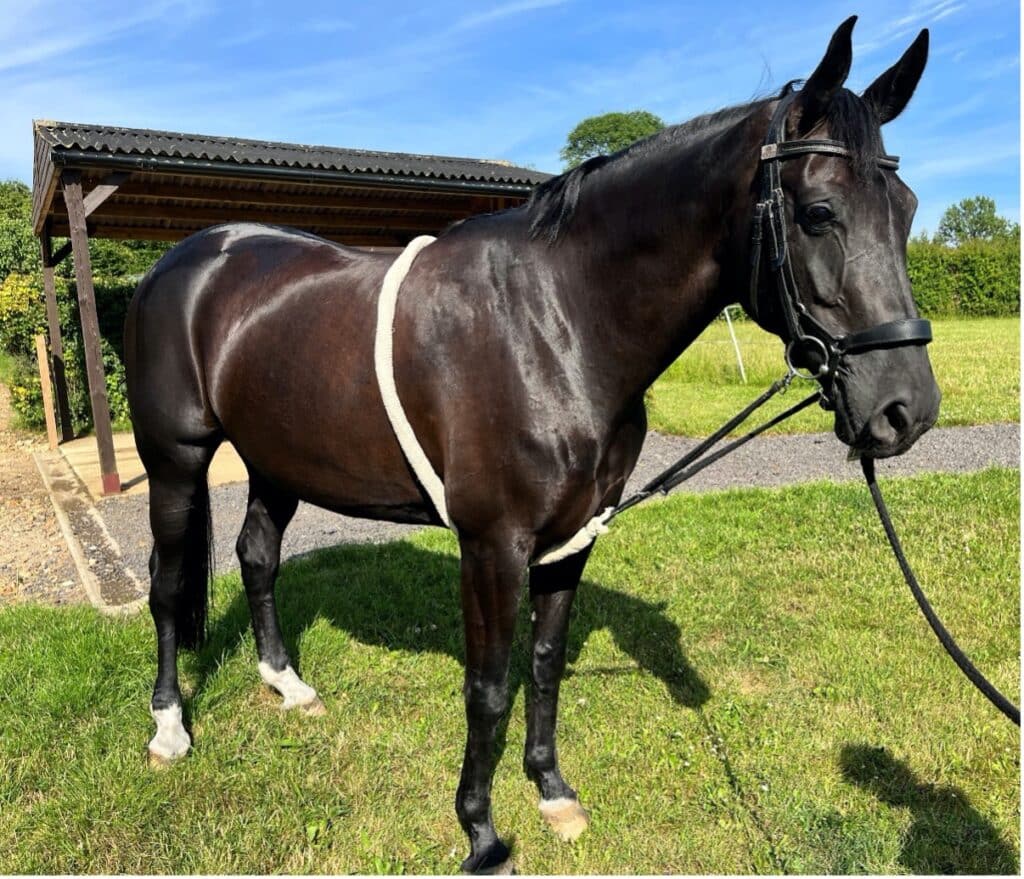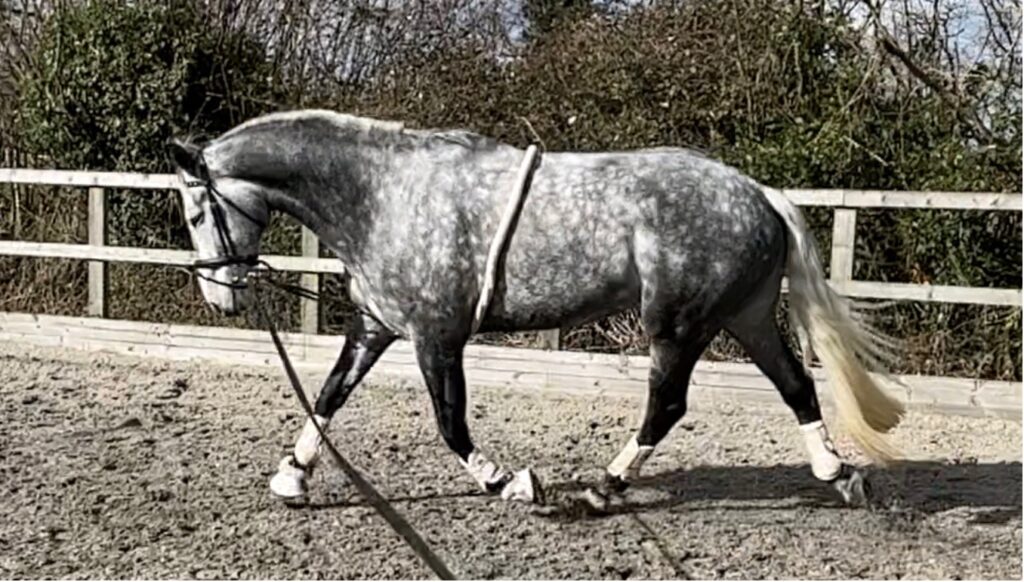Training, Training Aids, Training and Management
Training aids: the cotton lunge aid – is it more than just a rope?
Chloe Mabbutt, outlines what we need to know
The cotton lunge aid is not a new invention but, it is only recently rising in popularity. It is aimed for the user to need nothing else other than a bridle and lunge rope. It is utilised to encourage correct frame and self-carriage – but does it work? And why is it suddenly so popular?!

How are cotton lunge aids supposed to work?
The aid (according to manufacturers¹, is designed to encourage the horse to lift through its sternum (breast bone), thus lifting its shoulders, allowing a lighter forehand and a natural caudal neck lift. The natural caudal neck lift has been found to be important for correct “frame” due to engagement of the scalenus muscle, as the thoracic sling needs to provide spring momentum back to the hind limbs during stance to make movement energy efficient². There are theories that the aid acts to stimulate sensory receptors on the skin, alongside proprioceptors in the deeper underlying tissue, to activate the underlying musculature, just like the core resistance bands. This allows the creation and transference of energy from the hindlimbs to the forelimbs allowing forward “pushing” from behind, rather than “pulling” from the forehand, which is musculoskeletally efficient².
Do they actually work?
To date I have not found any studies specifically researching this piece of equipment and whether it does or doesn’t do what it says. Anecdotally…it seems to be well accepted by horses, with many paraprofessionals such as coaches and veterinary physiotherapists using it for training and rehabilitation purposes, to prevent use of tools such as rollers which create pressure points on the back³ and for ease of use! But, there is definitely a requirement for some solid research on its use.
Potential issues could be the placement of the aid remains in the T12-T13 region, where kissing spine is commonly found³; it sits just behind the elbows, which could reduce forelimb protraction if it follows the same trend of poorly fitting girths creating elbow pressure ⁴. However, as the aid is not tightly fitted, and aims to have no pressure when the horse is in the correct frame, it could be assumed these will not be an issue in practice.

How to use
The key thing with fitting all aids is they should not hold the horse in a frame (figure 2) when it is standing still; the horse needs room to move so the aid must be loose enough to allow limbs to move in opposing directions without pulling on them instantly. Fitting using the fist technique (figure 3), can prevent over tightening from occurring. Essentially all you need to do is place the aid on, and as you go to clip it to the bit rings, ensure the horse is standing naturally and comfortably with its head straight, then put your fist between the bit ring and clasp of the aid. This means you only “pull” a few inches to clip it to the bit, preventing over tightening while the horse is standing still.
“initially to prevent over working muscles that are not normally used, the cotton lunge aid should be worn only for a quarter of a normal lunging session, gradually increasing over a few weeks to the full time”
It is then simply a case of lunging as you would normally. The horse can walk, trot, canter, go over poles etc, all wearing the aid. However, as with all new training aids and equipment, it should be introduced gradually to your lunging sessions. Initially to prevent over working muscles that are not normally used, the cotton lunge aid should be worn only for a quarter of a normal lunging session, gradually increasing over a few weeks to the full time. Additionally, warming up and cooling the horse down for a few minutes without the aid on is always advisable, to ensure you are not over working or stretching cold muscles.
What other exercises can be used instead of a cotton lunge aid?
As this aims to “lift” the horse through the sternum and thus reduce weight on the forehand, exercises based on that aim will be discussed.
As mentioned in previous articles, carrot stretches to the chest, and between the front legs are great for building topline muscle that stabilises the spine⁵ and encouraging “rounding”; as-well-as being easy to incorporate into daily training!
Forelimb weight shifting (gently rocking the withers) is valuable to provide passive range of motion to the forelimb and caudal neck joints, allowing inflammation dispersal and for the supporting components of the joints to be appropriately contracted and relaxed for strengthening. Additionally, the weight-shifting excites the thoracic sling musculature, allowing these muscles to be strengthened whilst limiting high energy forces of excessive core conditioning work. And finally, backward weight-shifting (hand held on sternum and gentle pressure applied backwards to cause rocking), can help the horse alter their centre of mass backwards, taking the weight of the forelimbs, alongside contracting the thoracic sling musculature for strengthening⁶.
Belly lifts hypertrophy the multifidus (back muscle) creating spinal stability and preventing pain, and correct musculature recruitment for movement such as the epaxial and abdominal musculature⁵ ⁶. However, to specifically target the forehand and shoulders, you can perform a “sternal lift”, which is specifically lifting the forehand. Always ask a therapist to start to ensure the horse is capable and for you to be shown correctly how to complete the exercise.
As mentioned in the resistance band articles, Murray et al.⁷ found walking over-ground and raised poles significantly increased wither/sacrum/tuber coxae mediolateral swing, suggesting increased paraspinal musculature activation and spinal mobilisation, with trotting over poles providing maximal thoracic sling recruitment⁸. However, this must be performed gradually to prevent back pain from overworking a weak or injured back. Therefore, the cotton lunge aid may be gradually used to create a similar effect, and gradually linked with pole use. Additionally, it may be helpful for horses who have a fear of walking over poles, or who cannot for other medical reasons.
Transitions between gaits, encourages the horse to shift their wait on to the hind quarters and step under with the hindlimbs. This in turn allows greater flexion of the pelvis, lightening the forehand and allowing the core musculature to help achieve self-carriage² ⁹. Start off simple, such as walk-halt transitions, trot-walk, and progressing to trot-halt and even halt-canter, can encourage collection and engagement.
Take home message
The take home message here is, you should be using a combination of exercises alongside training aids to achieve the best results. It is key to work on a horse’s posture from the ground as well as under saddle. And, as I have mentioned before… if you use a training aid, check it is not having a detrimental effect on your horse’s movement; watch the horse with and without the aid regularly and, work with your vet, therapist and trainer to find the right methods for your horse!
References
- Cork Farm Equestrian. Mark Todd Lunging Aid Soft German Cotton Lunge Rope Harry Helps Stretch Back [online].Available: https://www.corkfarmequestrian.co.uk/products/mark-todd-lunging-aid-soft-german-cotton-lunge-rope-harry-helps-stretch-back?variant=39393566588999 [accessed 7/72022]
- Wagner, K., 2016. Equine Biomechanics and Locomotion. Keith Wagner Equine Veterinarian [online]. Available: https://wagnerhorsedoc.com/equine-biomechanics-locomotion/ [accessed 25/2/2022]
- Mackechnie-Guire, R., et al. 2018. Local Back Pressure Caused by a Training Roller During Lunging With and Without a Pessoa Training Aid. Journal of Equine Veterinary Science. 67: https://doi.org/10.1016/j.jevs.2018.03.018
- Murray, R., et al. 2013. Girth pressure measurements reveal high peak pressures that can be avoided using an alternative girth design that also results in increased limb protraction and flexion in the swing phase. The Veterinary Journal. 198(1): https://doi.org/10.1016/j.tvjl.2013.07.028
- Tabor, G., 2015. The effect of dynamic mobilisation exercises on the equine multifidus muscle and thoracic profile [thesis]. University of Plymouth. Accessed: http://hdl.handle.net/10026.1/3320
- Clayton, H.M., 2016. Core training and rehabilitation in Horses. Veterinary Clinics of North America: Equine Practice.32(1): https://doi.org/10.1016/j.cveq.2015.12.009
- Murray, R., et al. 2020. Effect of walking over ground poles and raised poles compared to no poles on limb and back kinematics in horses with different postures. Equine Veterinary Journal. 52: https://doi.org/10.1111/evj.10_13365
- Clayton, H.M., et al. 2015. Stance phase kinematics and kinetics of horses trotting over poles. Equine Veterinary Journal. 47: https://doi.org/10.1111/evj.12251
- Paulekas, R., and Haussler, K., 2009. Principles and practice of therapeutic exercise for horses. Journal of Equine Veterinary Science. 29(12): https://doi.org/10.1016/j.jevs.2009.10.019
Using the fist to fit correctly
Fitted cotton lunge aid
